Dragoman of the Porte
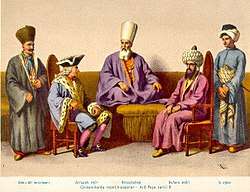
The Dragoman of the Sublime Porte (Ottoman Turkish: terdjümân-ı bâb-ı âlî), Dragoman of the Imperial Council (terdjümân-ı dîvân-ı hümâyûn), or simply Grand or Chief Dragoman (terdjümân bashı), was the senior interpreter of the Ottoman government and de facto deputy foreign minister. From the position's inception in 1661 until the outbreak of the Greek Revolution in 1821, the office was occupied by Phanariotes, and was one of the main pillars of Phanariote power in the Ottoman Empire.
History
In the Ottoman Empire, the existence of interpreters or dragomans (from the Italian rendering drog[o]man of Arabic tardjumān, Ottoman terdjümân) are attested from the early 16th century. They were part of the staff of the reis ül-küttab, who was responsible for foreign affairs within the Imperial Council. As few Ottoman Turks ever learned European languages, from early times the majority of these men were of Christian origin—in the main Austrians, Hungarians, Poles, and Greeks.[1]
In 1661, the Grand Vizier Ahmed Köprülü appointed the Greek Panagiotis Nikousios as Chief Dragoman to the Imperial Council. He was in turn succeeded in 1673 by another Greek, Alexander Mavrocordatos.[1][2] These men began a tradition where almost all subsequent Grand Dragomans of the Porte were of Greek origin or Hellenized as members of a small circle of Phanariote families, such as the Mavrocordatos, Ghica, or Callimachi clans.[1][2] Their prominence in this position, along with the similar post (established in 1701) of Dragoman of the Fleet,[3] eventually led to the appointment of many former Grand Dragomans to the positions of princes (voivodes or hospodars) of the Danubian Principalities of Wallachia and Moldavia.[1][3]
The Phanariotes maintained this privileged position until the outbreak of the Greek Revolution in 1821: the then Dragoman of the Porte, Constantine Mourouzis was beheaded, and his successor, Stavraki Aristarchi, was dismissed and exiled in 1822.[1] The position of Grand Dragoman was then replaced by a Translation Bureau, staffed initially by converts like Ishak Efendi, but quickly exclusively by Muslim Turks fluent in foreign languages.[1]
List of Dragomans of the Porte
| Name | Portrait | Tenure | Notes | Refs |
|---|---|---|---|---|
| Panagiotis Nikousios | 1661–1673 | |||
| Alexander Mavrocordatos | 1673–1697 | |||
| Nicholas Mavrocordatos | 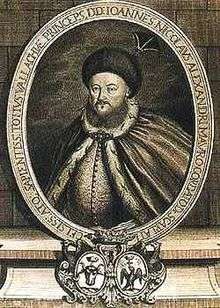 |
1697–1709 | Son of Alexander. Subsequently Prince of Moldavia (1709–1710, 1711–1715) and of Wallachia (1715–1716, 1719–1730) | |
| John Mavrocordatos | 1709–1717 | Son of Alexander. Subsequently Caimacam of Moldavia (1711) and Prince of Wallachia (1716–1719) | ||
| Grigore II Ghica |  |
1717–1727 | Subsequently Prince of Moldavia (1726–1733, 1735–1739, 1739–1741, 1747–1748) and of Wallachia (1733–1735, 1748–1752) | |
| Alexander Ghica | 1727–1740 | |||
| Ioan Teodor Callimachi | 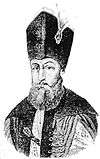 |
1740–1750 | ||
| Matei Ghica | 1751–1752 | Son of Grigore II. Subsequently Prince of Wallachia (1752–1753) and of Moldavia (1753–1756) | ||
| Ioan Teodor Callimachi |  |
1752–1758 | 2nd term. Subsequently Prince of Moldavia (1758–1761) | |
| Grigore III Ghica | 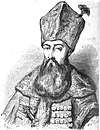 |
1758–1764 | Son of Alexander. Subsequently Prince of Moldavia (1764–1767, 1774–1777) and of Wallachia (1768–1769) | |
| George Caradja | 1764–1765 | |||
| Skarlatos Caradja | 1765–1768 | Son of George | ||
| Nicholas Soutzos | 1768–1769 | |||
| Mihai Racoviță | 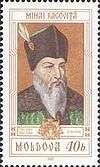 |
1769–1770 | Subsequently Prince of Moldavia (1703–1705, 1707–1709, 1716–1726) and of Wallachia (1730–1731, 1741–1744) | |
| Skarlatos Caradja | 1770–1774 | 2nd tenure | ||
| Alexander Ypsilantis | 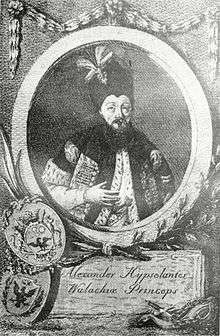 |
1774 | Subsequently Prince of Wallachia (1774–1782, 1796–1797) and of Moldavia (1786–1788) | |
| Constantine Mourouzis | 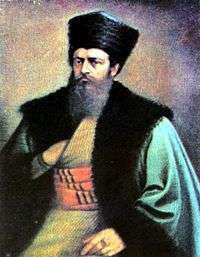 |
1774–1777 | Subsequently Prince of Moldavia (1777–1782) | |
| Nicholas Caradja | 1777–1782 | Son of Skarlatos | ||
| Michael Drakos Soutzos | 1782–1785 | Subsequently Prince of Wallachia (1783–1786, 1791–1793, 1801–1802) and of Moldavia (1792–1795) | ||
| Alexandru Callimachi | 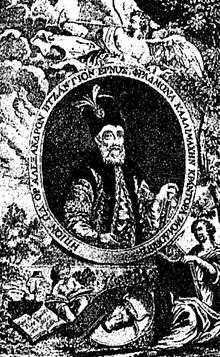 |
1785–1788 | Subsequently Prince of Moldavia (1795–1799) | |
| Constantine Rallis | 1788 | |||
| Manuel Caradja | 1788–1790 | |||
| Alexander Mourouzis | 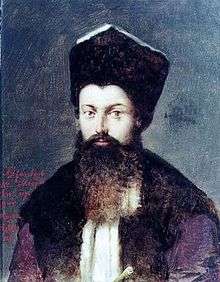 |
1790–1792 | Son of Constantine. Subsequently Prince of Moldavia (1792, 1802–1806, 1806–1807) and of Wallachia (1793–1796, 1799–1801) | |
| George Mourouzis | 1792–1796 | Son of Constantine. Subsequently Prince of Moldavia (1792, 1802–1806, 1806–1807) and of Wallachia (1793–1796, 1799–1801) | ||
| Constantine Ypsilantis | 1796–1799 | Son of Alexander. Subsequently Prince of Moldavia (1799–1801) and of Wallachia (1802–1806) | ||
| Alexandros Soutzos | 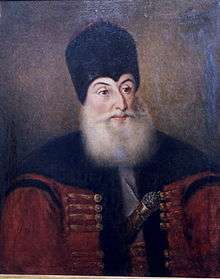 |
1799–1802 | Son of Nicholas. Subsequently Prince of Moldavia (1801–1802) and of Wallachia (1802, 1806, 1818–1821) | |
| Alexandros Soutzos | 1802–1807 | Son of Michael Drakos Soutzos | ||
| John Caradja | 1808 | |||
| Demetrios Mourouzis | 1808–1812 | |||
| John Caradja | 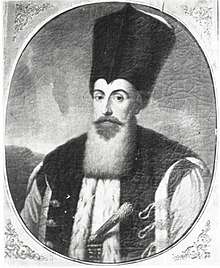 |
1812 | Subsequently Prince of Wallachia (1812–1818) | |
| Iakovos Argyropoulos | 1812–1815 | |||
| Michael Soutzos | 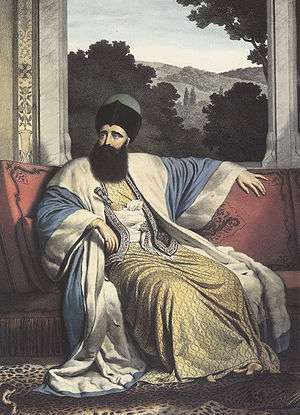 |
1815–1818 | Subsequently Prince of Moldavia (1819–1821) | |
| John Callimachi | 1818–1820 | |||
| Constantine Mourouzis | 1821 | |||
| Stavraki Aristarchi | 1821–1822 | |||
References
- 1 2 3 4 5 6 Bosworth 2000, p. 237.
- 1 2 Patrinelis 2001, p. 181.
- 1 2 Patrinelis 2001, pp. 180–181.
Sources
- Bosworth, C. E. (2000). "Tard̲j̲umān". In Bearman, P. J.; Bianquis, Th.; Bosworth, C. E.; van Donzel, E.; Heinrichs, W. P. The Encyclopaedia of Islam, New Edition, Volume X: T–U. Leiden: E. J. Brill. pp. 236–238. ISBN 90-04-11211-1.
- Patrinelis, C. G. (2001). "The Phanariots Before 1821". Balkan Studies. 42 (2): 177–198. ISSN 2241-1674.